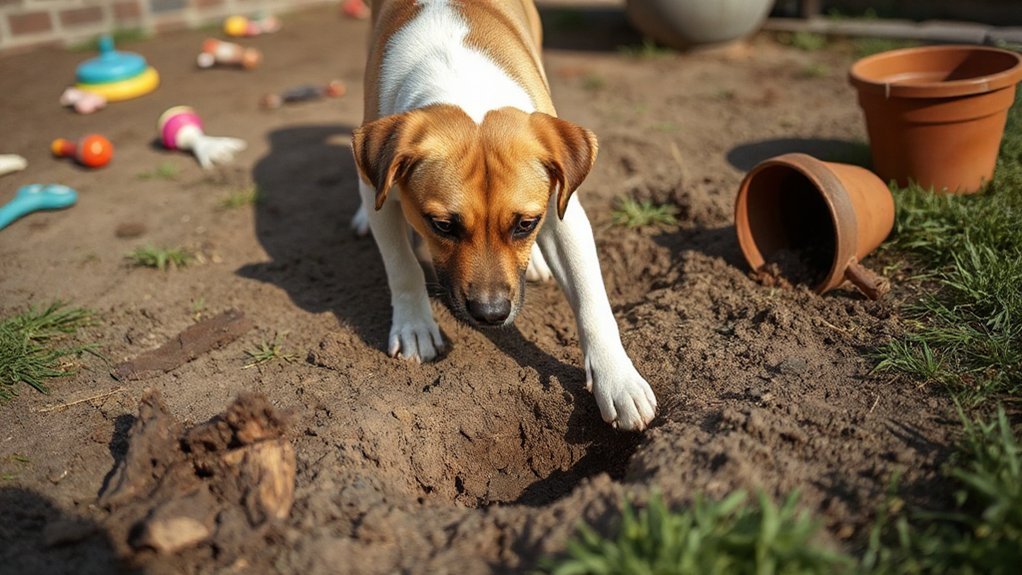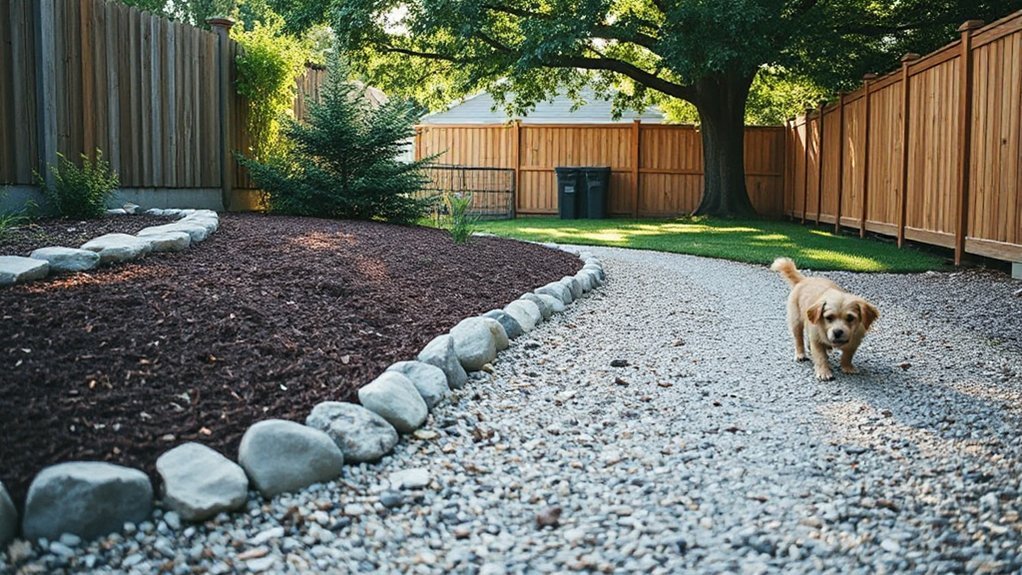If your dog keeps digging, you can stop it without harsh punishment by first understanding why they do it—boredom, hunting instincts, escape attempts, or comfort-seeking are common causes. You’ll want to manage energy with exercise, change the yard to remove temptations, and teach a preferred behavior or a special digging spot using consistent, positive training. There are practical steps that work for most dogs, and a few diagnostic tips if the problem persists.
Key Takeaways
- Increase daily physical and mental exercise to reduce excess energy that fuels digging.
- Create a designated digging area (sandbox or loose soil) and reward your dog for using it.
- Remove attractants (buried toys, food scraps, wildlife) and block persistent holes with barriers.
- Teach and reinforce alternative commands (e.g., “go dig,” “mat,” or fetch”) using positive reinforcement.
- If digging is sudden or excessive, consult your veterinarian or a behaviorist to rule out medical or anxiety causes.
Why Dogs Dig: Common Causes and How to Recognize Them

Although digging might look like mischief, it’s usually your dog responding to a real need or instinct. You should recognize digging as one of several natural behaviors driven by underlying instincts — hunting, denning, or conserving body heat. Dogs also dig for temperature regulation, creating cool spots in summer or insulated nests in cold weather. Pay attention to context: frantic, repetitive digging near doors or furniture can signal anxiety and need for anxiety reduction, while sporadic yard holes near boundaries may reflect territory marking. Puppies and social breeds dig for social interaction and play; bored dogs use digging for boredom relief. Stress relief digging often accompanies other signs (pacing, whining). Observing patterns helps you identify causes and respond compassionately.
Managing Excess Energy: Exercise and Mental Stimulation

If you’ve ruled out instinctive digging and anxiety, excess energy is a common driver you can tackle directly with activity and mental work. You’ll reduce digging by giving your dog predictable outlets: daily walks, runs, or play sessions matched to their breed, age, and health. Incorporate agility training to burn physical energy and sharpen focus; short, regular sessions build confidence and obedience. Use interactive toys—puzzle feeders, treat-dispensing balls, snuffle mats—to provide cognitive challenges that mimic foraging. Vary activities to prevent boredom and increase engagement. Monitor for signs of tired but happy behavior, not overstimulation. If you’re unsure how much or which activities suit your dog, consult a trainer or veterinarian to design a balanced routine that lowers digging impulses.
Making the Yard Less Tempting: Environmental Modifications

Start by removing things that attract your dog, like buried toys, grubs, or food scraps, since reducing rewards lowers digging motivation. Then block off persistent digging spots with low fencing, chicken wire, or plant-resistant barriers to make those areas inaccessible. Finally, give your dog acceptable alternatives—a sandpit or designated digging box filled with loose substrate—so they can satisfy the urge safely.
Remove Attractive Targets
Because dogs dig where there’s something worth finding, the quickest way to reduce digging is to make your yard less tempting by removing or securing whatever draws them in. You’ll lower the appeal by addressing attractive scents and anything that smells like buried treasures. Remove food scraps, secure compost, and clean up spilled pet food; scent is a powerful trigger. Store toys and bones indoors when not supervised. If wildlife (moles, birds) is attracting them, use humane deterrents and seal openings to burrows.
- A damp, fragrant compost heap that smells of food
- A forgotten chew toy half-buried under a shrub
- Mouse runs or bird nests in the lawn
These steps are practical, evidence-based, and kinder for you and your dog.
Block off Digging Zones
When your dog keeps returning to the same spots, you can reduce digging by physically blocking access to those areas with barriers and landscape changes that make digging harder and less rewarding. Start by identifying persistent holes and redirect traffic with low-cost solutions: plant dense groundcover, place decorative rocks, or install raised beds. Use dog proof fencing or short mesh borders around flowerbeds to prevent access without isolating the yard. Combine barriers with safe digging deterrents—crushed shells, chicken wire under soil, or motion-activated sprinklers—to make digging unappealing. Check local guidance to choose materials that won’t injure paws. Monitor changes and adjust; some dogs test boundaries, so gradually increase barriers while reinforcing desirable behavior with praise and supervised outdoor time.
Offer Alternative Substrates
One effective approach is to give your dog approved digging spots filled with attractive substrates, so they’re drawn away from beds and lawns. You’ll reduce unwanted holes by offering digging alternatives that satisfy the same instincts. Choose safe, durable alternative materials and supervise initial use so the spot becomes rewarding.
- A sandbox with loose, scent-free play sand and buried toys for discovery
- A mulched bed with soft, shredded bark where you hide treats
- A gravel patch edged with logs to mimic natural terrain
Place these areas where your dog already digs, reinforce use with praise and play, and remove enticements from problem zones. Consistent redirection plus rewarding use of alternatives is supported by behavior-change principles.
Teaching Alternative Behaviors and Redirecting Digging
Offer your dog a purposeful alternative to digging so you can redirect the behavior without punishment. Give clear behavioral cues tied to rewarding activities: teach “go dig,” “mat,” or “toy” and reward the behavior immediately so your dog learns what you want. Use alternative distractions like puzzle feeders, buried toys in a sandbox, or scent games to satisfy digging instincts while keeping soil and plants safe. When you see early signs of digging, calmly interrupt with a cue, guide your dog to the chosen alternative, and reinforce success with praise or a treat. Repeat sessions short and frequent; consistency and predictable rewards build reliable responses. This compassionate, evidence-based approach replaces unwanted digging by teaching a desirable habit.
Training Techniques to Deter Digging Without Punishment
Make sure your dog gets more supervised exercise, since regular walks and playtime reduce excess energy that often fuels digging. Offer an approved digging area—like a sandbox with toys and buried treats—and encourage use of it so they learn where digging is allowed. When you catch them starting to dig in the wrong spot, calmly redirect to the approved area and reward the switch with praise or a treat.
Increase Supervised Exercise
Increasing your dog’s supervised exercise is one of the most effective, humane ways to reduce digging driven by excess energy or boredom. You’ll see fewer holes when you plan consistent sessions that combine increased activity and purposeful physical engagement. Aim for varied, supervised outings so your dog stays mentally and physically satisfied and you can redirect digging impulses immediately.
- Picture a brisk 20-minute walk, ears perked, nose exploring new scents.
- Imagine a focused fetch session, muscles working, tail wagging between reps.
- Visualize short training circuits in the yard: sit, recall, weave, reward.
Evidence shows exercise reduces problem behaviors. Supervise so you can praise calm behavior and interrupt digging attempts. Keep sessions regular, safe, and matched to your dog’s age and breed.
Provide Approved Digging Areas
If you channel your dog’s digging into a dedicated spot, you’ll satisfy their instinct without losing your yard. Create approved digging zones by choosing an accessible, visible corner and filling it with loose soil or sand. Teach your dog the designated digging area by taking them there when they show interest, gently guiding paws, and rewarding calm digging with praise or a small treat. Consistently redirect attempts elsewhere toward that spot so the behavior becomes routine. Keep the approved area attractive: bury toys or chews to encourage use, refresh soil as needed, and fence the rest of the yard if necessary to prevent accidental access. This compassionate, evidence-based approach respects natural behavior while protecting landscaping.
Use Positive Redirection
Redirect your dog’s digging by replacing the unwanted behavior with an appealing alternative they can succeed at. Use positive reinforcement and gentle behavior modification: catch them before they start, interrupt with a cue, then guide them to an approved activity. Reward immediately when they choose the new option so the association strengthens.
- A shady spot with a soft, scented box where they can paw and dig safely.
- A shallow pool or sandbox filled with toys and treats buried slightly for scent play.
- A supervised digging session paired with short walks and puzzle toys afterward.
Be consistent, patient, and prompt; science shows immediate rewards shape choices. You’ll build skills without punishment, protect your yard, and keep your bond strong.
Creating a Designated Digging Area Your Dog Will Love
Because digging is a natural outlet for many dogs, giving them a dedicated spot lets you meet that need without sacrificing your yard, and it’s easier to teach than to suppress the behavior everywhere. Choose a designated area with loose, diggable soil or sand, placed where you won’t mind activity. Observe your dog preferences — some dogs like deep holes, others prefer shallow scoops — and design the pit accordingly. Bury toys or treats to encourage use, praise and reward when they dig there, and redirect them calmly to the spot if they start elsewhere. Maintain the area by replenishing material and rotating buried rewards. Consistent reinforcement and matching the setup to your dog’s natural style reduces unwanted digging while respecting their instincts.
When to Seek Professional Help: Trainers and Veterinarians
A designated digging area will solve many routine cases, but sometimes you’ll need outside help to understand or change the behavior. If digging is sudden, excessive, or paired with other changes, schedule a veterinary checkup to rule out pain, parasites, or neurological issues. If motivation is unclear—fear, boredom, hunting instincts—book a professional behavioral assessment with a certified trainer or applied animal behaviorist.
Think of these scenarios:
- a restless dog digging at night under fence panels, frantic and incessant
- a senior dog suddenly excavating near hips or back, seeming uncomfortable
- repeated, focused digging after specific triggers like lawn mowers
A collaborative plan from your vet and trainer gives targeted, humane strategies backed by evidence.
Conclusion
You can stop digging by addressing the cause, not punishing the symptom. Give your dog regular exercise and mental stimulation, remove tempting targets, and teach an alternative—then consistently redirect to a designated dig spot filled with loose soil and buried toys. Use reward-based training, keep reactions calm, and be patient; persistent digging may signal anxiety, boredom, or a medical issue. If it continues despite your efforts, consult a trainer or veterinarian for tailored, humane guidance.